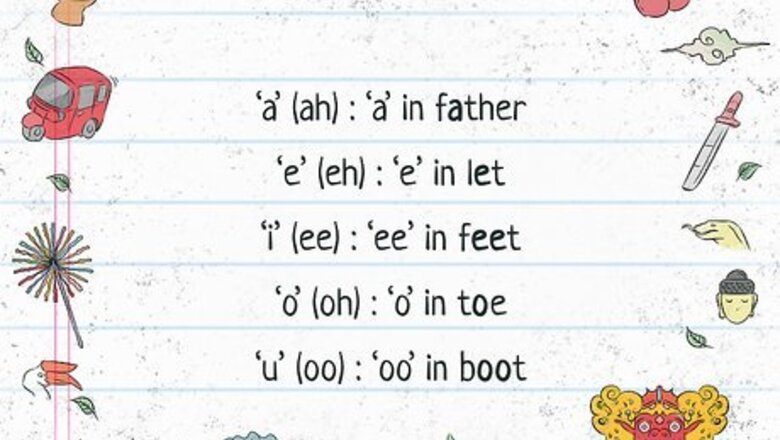
views
X
Research source
Pronouncing the Indonesian Alphabet

Start with vowel sounds. Bahasa Indonesia has 5 vowels, the same as in English. However, in Bahasa Indonesia, vowels typically only make one sound. This differs from English, in which vowels can be either long or short. The letter "a" makes an "ah" sound like the "a" in the English word "father." The letter "e" makes an "eh" sound similar to the "e" in the English word "let," but slightly more rounded. Think of combining the "eh" sound with the "a" sound in the English word "late." The letter "i" makes an "ee" sound like the "ee" in the English word "feet." The letter "o" makes an "oh" sound similar to the "oe" in the English word "toe," but more rounded. Think of combining the "oh" sound with the "aw" sound in the English word "saw." The letter "u" makes an "oo" sound like the "oo" in the English word "boot."
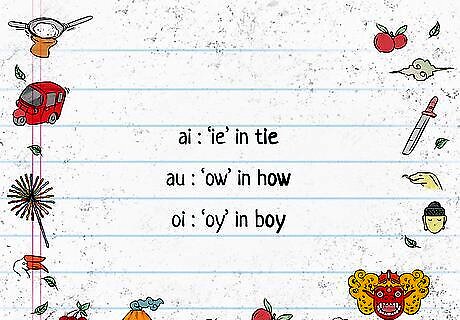
Blend the vowel sounds in diphthongs. Bahasa Indonesia also has 3 diphthongs, which are a combination of 2 vowels blended together to produce a different sound than the 2 letters would make separately. These diphthongs always have the same sound. The diphthong "ai" sounds like the "ie" in the English word "tie." The diphthong "au" sounds like the "ow" in the English word "how." The diphthong "oi" sounds like the "oy" in the English word "boy."Tip: If you see 2 vowels together that are not one of these 3 diphthongs, pronounce each of them separately with a slight pause in between.
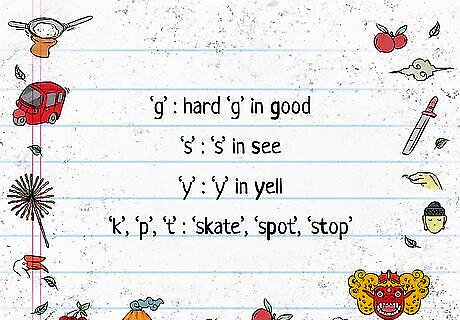
Use most of the same consonant sounds you would in English. Bahasa Indonesia uses the same alphabet as English, and most of the consonants are pronounced the same way. However, some are more limited than their English counterparts. There are also a few consonants that are pronounced differently, so if you're learning Bahasa Indonesia, you'll need to practice those. The letter "g" is pronounced like the hard "g" in the English word "good." However, it never has a soft sound, like the "g" in the English word "giant." The letter "s" is pronounced like the "s" in the English word "see." It never has a softer "z" sound, like the "s" in the English word "boys." The letter "y" always has a hard consonant sound, as in the English word "yell." The letters "k," "p," and "t," aren't aspirated (said with the exhalation of a short puff of air), as in the English words "kill," "put," and "tap." Rather, they always sound like "skate," "spot," and "stop."

Practice compound consonants. Bahasa Indonesia has 4 compound consonants, also known as "digraphs." With these consonant blends, the 2 consonant sounds combine to produce a different sound than the 2 letters might if they appeared in a word separately. As with diphthongs, when you see any other 2 consonants together in a Bahasa Indonesia word, pronounce each letter separately rather than blending them together. The digraph "ng" sounds like the "ng" at the end of the English word "sing." This digraph also appears at the beginning of words, which is a sound that can be difficult for native speakers of Western languages, although it's common in other Asian languages. The digraph "ny" sounds like the "ny" in the English word "canyon." The digraph "sy" sounds like the "sh" in the English word "shoe." It is only used in words of Arabic origin. The digraph "kh" sounds like the "ch" in the Scottish word "loch." It is only used in words of Arabic origin.
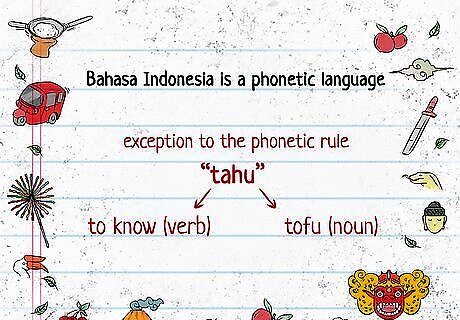
Sound out most words exactly as they're spelled. Bahasa Indonesia is a relatively easy language to learn because it is a phonetic language, meaning the words are pronounced exactly as they're spelled. Once you know how to pronounce the alphabet, you can sound out words that you see in print, even if you don't quite understand what they mean. One exception to the phonetic rule is the word "tahu." The word is either a verb meaning "to know" or a noun meaning "tofu." As a verb, the "h" is silent and you pronounce the word similar to the word "tao." If the word means "tofu," you pronounce it phonetically: "tah-hoo." Fortunately, when reading Bahasa Indonesia, you can usually tell from the context which word is meant.
Having Basic Conversations
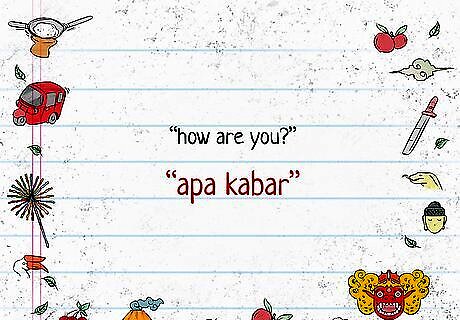
Use "apa kabar" as a general greeting. "Apa kabar" (which literally translates to "what news?") is technically how you would say "How are you?" However, the phrase is also used as a general greeting, similar to "hello." It's appropriate in most settings if you're greeting a friend or a stranger your age or younger. You can also simply say "hi." While this isn't a strictly Indonesian greeting, it's the most common casual greeting among native speakers.Tip: If greeting someone older than you or in a position of authority, use the more formal "Salam sejahtera."

Try different greetings based on the time of the day. As with many other languages, there are different Indonesian greetings that you can use depending on the time of day. These are general greetings that can be used in any context. Selamat pagi (good morning: dawn — 11 a.m.) Selamat siang (good day: 11 a.m. — 3 p.m.) Selamat sore (good afternoon: 3 p.m. — sunset) Selamat malam (good evening: sunset — dawn)
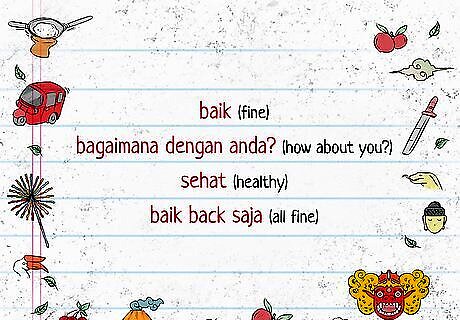
Say "baik" to reply to "apa kabar." "Baik" is the simplest response, meaning "fine." If the person says "apa kabar" before you do, you might add "Bagaimana dengan Anda?" (How about you?) This is the polite, formal version. When speaking to friends, ask "Bagaimana denganmu?" You can also say "sehat," which means "healthy" or "baik-baik saja," which means "just fine."

Introduce yourself with "nama saya" followed by your name. If you want to continue talking to someone, you typically would introduce yourself first. Use your first name after "nama saya." Don't worry about trying to translate your name into Indonesian — just pronounce it the way you normally would. To ask the other person their name, say "Siapa nama Anda?" While this is the formal version of the question, that's typically the version you'd use if you were meeting someone for the first time. When the person introduces themselves, you might also say "senang bertemu dengan Anda," which means "nice to meet you."
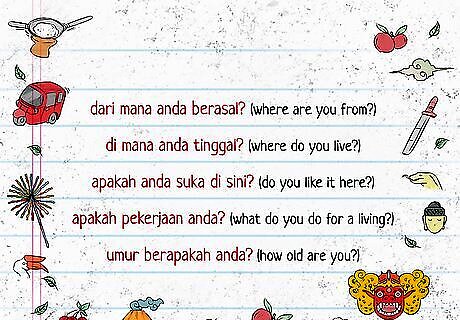
Continue the conversation by asking the other person questions. As in any language, asking the other person questions is a good way to keep a conversation going. It can also help you pick up more of the language to listen to the person's answers. Good questions to ask include: Dari mana Anda berasal? (Where are you from?) Di mana Anda tinggal? (Where do you live?) Apakah Anda suka di sini? (Do you like it here?) Apakah pekerjaan Anda? (What do you do for a living?) Umur berapakah Anda? (How old are you?)
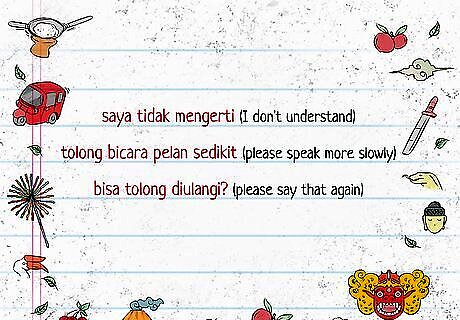
Let the other person know if you don't understand something they said. Especially when you're just starting to learn Indonesian, it's likely that your conversational partner will say things that go over your head. Let the person know quickly that you didn't understand them with the following phrases: Saya tidak mengerti (I don't understand) Tolong bicara pelan sedikit (Please speak more slowly) Bisa tolong diulangi? (Please say that again)
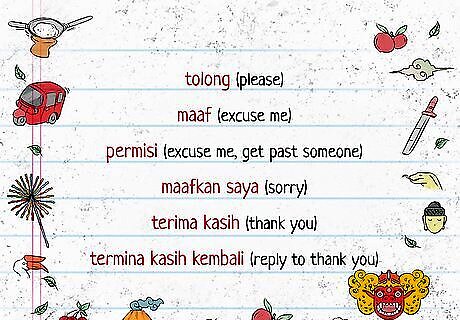
Show respect with polite words and phrases. Indonesians value politeness and respect, especially if you're talking to someone older than you or in a position of authority. Polite words and phrases you should know include: Tolong (please) Maaf (excuse me) Permisi (excuse me, if you want to get past someone) Maafkan saya (sorry) Terima kasih (thank you) Termina kasih kembali (reply to thank you)
Building Your Vocabulary

Label items around your home with Indonesian words. Use sticky notes to easily expand your vocabulary. Search online for the words in Indonesian for common items around your home, then apply the sticky note with the word to the item. Each time you pass by the item, say the Indonesian word. Over time, you'll likely come to think of these items by their Indonesian word rather than the corresponding word in your native language. Here are some words to get started: Kamar mandi (bathroom) Tempat tidur (bed); kamar tidur (bedroom) Langit-langit (ceiling) Lantai (floor) Kursi (chair) Dapur (kitchen) Meja (table) Dinding (wall)
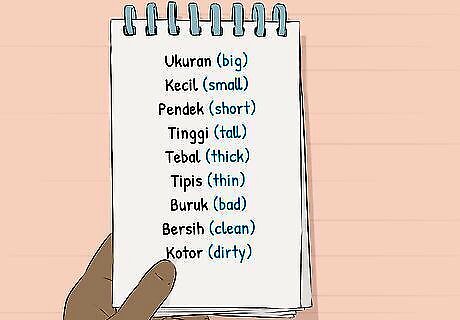
Memorize a few basic adjectives in Bahasa Indonesia. Adjectives are used frequently in normal conversation, but you likely tend to use only a few basic ones on a regular basis. If you learn the same basic adjectives in Bahasa Indonesia, you'll be able to have a conversation in Indonesian similar to one you'd have in your native language. Basic adjectives to commit to memory include: Ukuran (big) Kecil (small) Pendek (short) Tinggi (tall) Tebal (thick) Tipis (thin) Buruk (bad) Bersih (clean) Kotor (dirty)
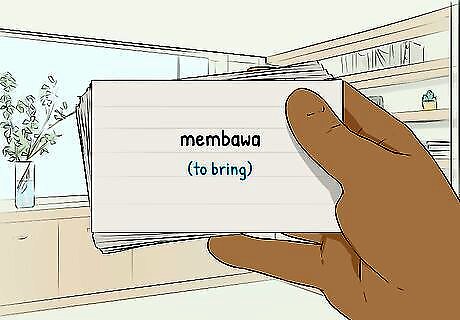
Create your own flashcards for other common words. You can learn a lot of basic vocabulary by labeling items around your home, but those words will generally only get you so far. After all, most people don't spend their day talking about furniture and other household items. Make a list of words (or categories of words) that you use on a regular basis, then look up their Indonesian equivalent. Once you've found the Indonesian word, do an image search online for that word. Save a few images that stick out to you and use them to create flashcards. You can either print the pictures and write the Indonesian word on the back, or you can use them as digital flashcards — save them in their own album in your photo app, then create a "key" document with the word for each picture.

Use GIFs to learn common Bahasa Indonesia verbs. If the photo flashcards work for you to learn nouns, moving photos (in the form of GIFs) can help you learn verbs. Simply repeat the same process you did with nouns, searching for GIFs that relate to the Indonesian verb you want to learn. Here are a few to get you started: Bertanya, meminta (to ask) Membawa (to bring) Membeli (to buy) Memanggil (to call) Memilih (to choose) Minum (to drink) Makan (to eat) Pergi (to go)
Expanding Your Knowledge
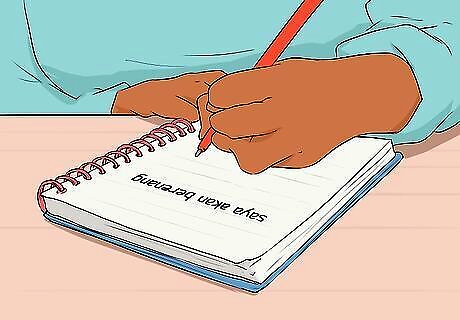
Use simplified grammar rules and sentence structure. Unlike most languages, Bahasa Indonesia doesn't have a lot of complex grammar rules that you might be familiar with from other languages, including English and European languages. This lack of rules can make the language a lot easier to pick up. Grammar rules you don't have to worry about include: No gender: Unlike in many European languages, such as Spanish or French, Indonesian nouns do not have a gender, so you don't have to worry about whether something is either male or female. No plurals: Nouns don't change their form to indicate that they're plural. Rather, you figure out whether a noun is singular or plural from the context of the sentence. No conjugations: Verbs do not change form in Bahasa Indonesia. You don't have to worry about the verb agreeing with the subject, because the verb form is always the same regardless of the identity or number of the subject (and remember, nouns don't have a plural form). No tenses: Technically speaking, verbs don't change their form to indicate past, present, or future tense. Rather, you simply add a single word in front of the verb to indicate past or future tense. For example, using the verb "berenang" (swim), you could say "Saya akan berenang" (I will swim) or "Saya berenang" (I swam; literally "I already swim").

Read books and articles written in Indonesian. Search online for Indonesian websites to read articles written in Bahasa Indonesia. You may also be able to order books in Bahasa Indonesia (or download eBooks) from your favorite online retailer. Since Bahasa Indonesia is a phonetic language, you should have no trouble sounding out the words. However, it's a good idea to keep a dictionary at hand so you can look up the definitions of words that you don't know. Keep in mind that the language you read in books and articles can be very different from the casual Indonesian spoken by native speakers. Imitating the written word in speech can make you sound stiff and formal (although people will still generally understand you).

Find an Indonesian conversation partner locally or online. Spoken Indonesian is very different from the textbook Indonesian you'll be taught in classes or through apps. For this reason, if you truly want to learn how to communicate in Bahasa Indonesia, you need to find someone who speaks the language and learn from them. Look for local Indonesian groups or search online for a language exchange partner. Keep in mind that many Indonesians don't speak Bahasa Indonesia, and many more who do speak it as a second or third language. It can be more difficult to find people who speak Bahasa Indonesia as a first language. Sometimes it's best if you let a native speaker do most of the talking. Learn to listen and comprehend what the person is understanding first. Then, you can try to communicate yourself.

Listen to Indonesian music. Search for Indonesian music on your favorite music streaming service or download music with Bahasa Indonesia lyrics. Music is particularly helpful when learning a language because the lyrics are repetitive and typically cover common life themes. Even if you're not actively listening, just having music on in the background can help you absorb the sounds of the language. You can also listen to news reports, interviews, and other broadcasts from SBS Indonesia for free at https://www.sbs.com.au/language/indonesian.

Watch videos with people speaking Bahasa Indonesia. Indonesian movies and television provide a great opportunity to watch and listen to people speaking Bahasa Indonesia. You can also watch conversations and interviews to get a feeling for the rhythm of the spoken language. There are many videos available on YouTube for free. Global news networks, such as CNN, also have websites where you can watch broadcasts and read news articles in Bahasa Indonesia. If you have an Android device, download the TV Indonesia app. It will give you access to all of the Indonesian TV channels.
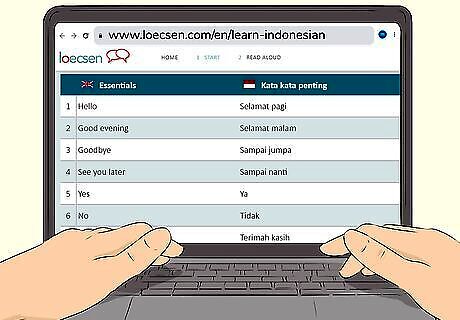
Take a free course in Indonesian to deepen your understanding of the language. There are many websites and apps, such as Duolingo, where you can learn Indonesian for free. In addition to the free courses, there are others that you can only access if you buy a subscription. Subscription apps may be more in-depth than free courses, or may have more support and interaction available. However, you can learn just as much from a free app if you're dedicated and self-motivated.

Enroll in a formal course if you plan to live in Indonesia. Indonesia is a favorite of global expatriates. You can typically get around as a tourist in larger cities, such as Jakarta or Bali, just fine without learning Bahasa Indonesia. However, if you're planning on living in the country for a more extended period, it's best to take a course in the language soon after arriving. These courses are plentiful, especially in large cities, and aren't very expensive to enroll in. If you're an expat, consider taking a 2- or 4-week intense immersion course so you can learn the language more quickly. If you're working for an employer in Indonesia, they'll typically pay for at least 40 hours of language instruction.

Visit Indonesia to talk to locals. If you're able to travel to Indonesia, you'll have plenty of opportunities to speak in Bahasa Indonesia. Even though you can usually get around in major cities and tourist areas speaking only English, there are also plenty of Indonesians who will be happy to chat with you in their native tongue. Even if you can't visit the country, you can still find an Indonesian pen pal or conversation partner online. Search online language exchange sites for Indonesian speakers.

Immerse yourself in Indonesian without leaving home. Immersion is one of the quickest ways to learn a language. Even if you have no plans to visit Indonesia, you can still immerse yourself in the language by making a few tweaks to your daily routine: Change the language settings on your phone or computer so that all of the menus and options are in Indonesian. While you'll likely only learn a few words this way, it helps you get in the habit of thinking in Indonesian rather than in your native language. When you're watching TV or a movie, turn on Indonesian subtitles if they're available. Read and pay attention to the subtitles as you're listening in your native language. Cook an Indonesian dish for dinner from a recipe written in Bahasa Indonesia. Not only do you get the opportunity to experience Indonesian culture, but you can also practice functional use of the language.



















Comments
0 comment